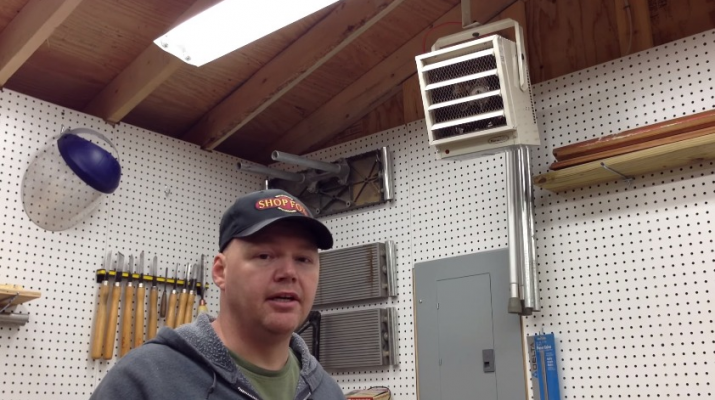The Science of Heating: Types of Electric Resistance Heating Elements
At the heart of every electric space heater is a heating element. No matter how big the heater is, no matter whether it's radiant heat, oil-filled, or fan-forced, somewhere inside is a heating element whose job is to convert electricity into heat.
Sometimes you can see the heating element, glowing red-hot through a protective grille. Other times it's hidden inside, protected by casings of metal and plastic, but pumping out heat all the same. What the heating element is made from and how it's designed directly affect how well the heater works, and how long it will continue to work.
An Introduction to Resistive Heating
Definitions of Related Terms
Ohm - Unit of electrical resistance
Sieman - Unit of electrical conductance.
Joule - Unit of energy.
Watt - Unit of power, equivalent to one joule per second.
Volt - Voltage, unit of electric potential, the difference of potential that would drive one ampere of current against one ohm resistance.
Amp - Ampere, unit of electric current, the flow of electric charges through a surface.
BTUs - British Thermal Unit, used to measure heat values, 1 BTU = heat from one matchstick; BTU/hr = 3.41 x Watts.
Resistive heating is the process by which an electric current passes through a conductive material (the resistor) and releases heat. The greater the resistance the electricity encounters, the more heat is created. This can be measured as a value of "electrical resistance", and its inverse property is measured as "electrical conductance."
The formula for defining resistance is:
Resistance = Voltage / Amps
A superconductor (such as those materials used in high tech applications like MRI machines, mass spectrometers, and particle accelerators) have an electrical resistance of zero, which means no heat at all is created as the electrical current passes through the object. But space heaters (along with toasters, coffee makers, hair dryers, and just about any other appliance with a heating function) are engineered with materials with higher electrical resistivity on purpose, to take advantage of that heat-generating property.
The actual heat output is a function of the supply voltage and the heater resistance:
Watts = Voltage² / Resistance
If resistance is too high, no electricity goes through the material at all, so no heat is produced. Therefore, selecting the right resistive material for a heating element is crucial in order to maximize heat output and energy usage.
Resistance Wire
By far, the most commonly used material for heating elements are metal wires or ribbons, generally called resistance wire. These can be coiled tight or used as flat strips, depending upon the configuration of the appliance. The longer the piece of wire, the more heat it will generate.
Though various alloys are used for specialized applications, Nichrome remains the most popular used for space heaters and other small appliances. Nichrome 80/20 is an alloy of 80% nickel and 20% chromium. These qualities make it a good heating element:
- Relatively high resistance
- Easy to work and shape
- Doesn't oxidize or deteriorate in air, so it lasts longer
- Doesn't expand much when it heats up
- High melting point of about 2550°F (1400°C)
Other commonly found alloys in heating elements include Kanthal (FeCrAl) and Cupronickel (CuNi), although these aren't commonly used in space heaters.
Ceramic heaters
Recently, ceramic heating elements have been growing in popularity. These operate under the same principals of electric resistivity as resistance wire, except the metal is replaced by PTC ceramic plates.
PTC ceramic (usually barium titanate, BaTiO3) is so named because it has a positive thermal coefficient of resistance, which means resistance increases upon heating. This self-limiting property acts as a natural thermostat - the ceramic material heats quickly, but plateaus once a pre-defined temperature is reached. When the temp increases, resistance increases, resulting in decreased heat output. This provides uniform heating without power variation.
The advantages of ceramic heaters include:
- Fast warm up
- Low surface temperature, reduced fire risk
- Long life
- Self-regulating function
In most space heaters, ceramic panels are arrayed in a honeycomb configuration, and attached to aluminum baffles which direct the heat out of the heater into the air, with our without the assistance of a fan.
Radiant or Infrared Heat Lamps
The heaters mentioned so far are convection heaters: This means the heating element warms the air that passes over it, and then the warm air is distributed through the room. Radiant heaters are distinct because, instead of warming the air, they emit infrared waves that warm what they come in contact with, much like the rays of the sun warming the surface of the earth.
If you've ever put your hand next to a light bulb, then you've experienced the effects of radiant heat. As you may be aware, a standard incandescent light bulb is very inefficient, with as much as 95% of the energy fed into the filament converted to infrared heat instead of light. While this is bad news as far as lighting efficiency goes, it is good for heaters designed to produce radiant heat. A heater that is labeled a "radiant heater" or "infrared heater" is basically a heat lamp, a high-powered incandescent bulb that radiates more heat than light.
The filament in a light bulb functions as a length of resistance wire, though made of tungsten for increased light output when heated (that is, incandescence). The hot filament is encased in glass or quartz, which is either filled with inert gas or evacuated of air in order to protect it from oxidation.
In a space heater, the heat lamp filament is typically Nichrome, and energy is fed through it at less than maximum power, so that the filament radiates infrared instead of visible light. In addition, the quartz sheathing is often tinted red in order to reduce the amount of visible light that is emitted (it would be painful for our eyes, otherwise). The heating element is usually backed by a reflector that directs heat in a single direction.
The advantages of radiant heat lamps are:
- No heat up time, you feel warmer immediately
- Operate silently, since there is no hot air needing a fan
- Provide spot heating in open areas and outdoors, where heated air would dissipate
No matter what kind of heating element your heater has, there is one advantage that they all possess: electric resistance heaters are nearly 100% efficient. That means all the electricity that enters the resistor is converted into heat for your space. That is a benefit everyone can appreciate, especially when it comes time to pay the bills!





Heating element
I would like to thank you for the efforts you have made in writing this blog. Very Informative post.
Chhaperia Electro Components Pvt.Ltd. on